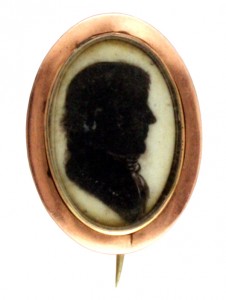Jewelry Mementos Before Photography – Our Oldest Estate Item
December 30th, 2008 by James L. Sweaney, CGA, FGA. GGOne of the fascinating things about jewelry is how often it reflects history. We have a very interesting pin that shows just how much our world has changed in the past two centuries– just compare this pin with the item described in our previous Blog, 3-D Precious Portraits!

This may be the oldest item in our estate department. It’s a silhouette portrait pin in 14K rose gold that probably dates to the early 19th century.
Silhouette jewels were crafted of black paper or card cut in profile, which was then attached to or cemented on to a base of light colored material such as ivory, bone, wood or porcelain. A glass cap covers the work, which is set into a bezel. Details and touchups were sometimes added in India ink. These pieces were greatly in vogue during the early years of the United States, especially from 1790 to 1840, because paper cuts were much less expensive than formal portraits done in oil paint or jewelry enamels. The advent of photography around 1840 ended the popularity of the silhouette. During the late 19th century, the silhouette portrait was popular in mourning jewelry. Today, the art of the paper cut remains as a nostalgic way to capture the likeness of a loved one—silhouette artists still ply their trade at fairs and amusement parks, and are especially popular at weddings.
Even though it’s well over 100 years old, our silhouette pin, I-17346, has survived in very good condition and is priced at $495. Its timeless style makes is an excellent accent for a suit jacket or a casual sweater or blouse. Talk about a conversation starter!
Tags: Antique Jewelry, Estate Jewelry, Mourning Pin, Silhouette Portrait, Victorian Jewelry








December 30th, 2008 at 11:08 pm
How was the glass cap held on? By a type of glue or was the bezel somehow manipulated?
What is the proper care for a piece like this?
January 9th, 2009 at 2:06 pm
Brian–
This particular silhouette has been set by the traditional bezel setting method, where the thin metal of the bezel is carefully pressed or “rolled” inward onto the edge of the glass cap. The original jeweler may have also used cement as well, but I can’t detect any, even by looking under the microscope.
The care of an item like this is fairly specific. First, DO NOT immerse in liquid-the bezel setting is not waterproof. Immersion may damage the paper cut silhouette.
Second, with any antique item, respect its age. Handle it gently, don’t stack things on top of it, etc., and when you wear the pin, be sure to engage the clasp carefully. The karat gold body of the pin and the glass cap may be carefully wiped with a soft cloth, but don’t polish aggressively-the soft luster of antique jewelry depends on the patina built up over years of careful wear. Last, buy it, wear it, love it!